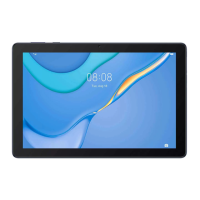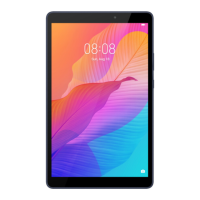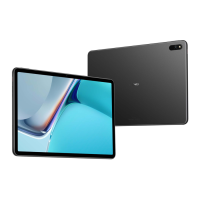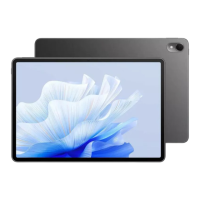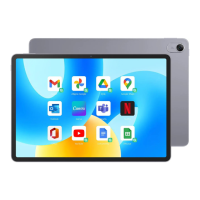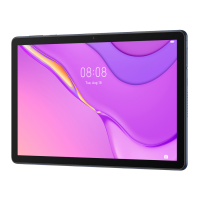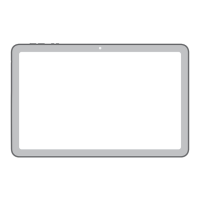Do you have a question about the Huawei MatePad BAH4-W09 and is the answer not in the manual?
Explains system navigation gestures like returning to previous screen, home screen, recent tasks, and closing apps.
Instructions on how to move data from an old device to a new one using Tablet Clone.
Explains how to manually lock the screen, set screen timeout, and turn the screen on.
Introduces service widgets and how to use them on the home screen for quick access.
Explains various icons displayed in the status bar and notification panel.
Steps to turn on, use, and customize shortcut switches in the Control Panel.
Manages music playback and switches between audio apps in the Control Panel.
Explains how Super Device enables collaboration between different Huawei devices.
Details methods for taking screenshots using knuckles, key combinations, or Control Panel shortcuts.
Guide on how to record the device's screen activity using various methods.
How to edit the dock and use split-screen for multitasking.
How to open and use apps in floating windows for multitasking.
Information and safety guidelines related to charging the device.
Using voice commands to interact with the device and its features.
Using AI Voice for real-time voice and text translation.
Using the camera to scan and translate text or learn about objects.
Using touch gestures to get more information about onscreen content.
Sharing files wirelessly between Huawei devices and computers.
Printing photos and documents from the device to nearby printers.
Manages music playback across different devices.
Different ways to open the camera application.
Basic steps for taking photos, including focusing, adjusting brightness, and zooming.
Advanced camera settings for manual control over photo capture.
Applying Pro Mode settings for video recording.
Basic instructions for capturing video footage.
Applying visual filters and creating time-lapse videos.
Customizing various camera settings for better performance.
Organizing, viewing, and editing photos and videos.
How to initiate phone calls by dialing numbers or selecting contacts.
Setting rules to block unwanted spam calls.
Setting up and using the SOS feature for emergencies.
Sending and receiving text messages, including managing conversations.
Scheduling activities and setting reminders.
Setting and managing alarms.
Creating and managing notes, checklists, and to-dos.
Recording, playing, editing, and sharing audio files.
Setting up email accounts and managing emails.
Using two instances of an app simultaneously.
Optimizing device storage and performance.
Securing the device with passwords, vaults, and app locks.
Connecting to and managing Wi-Fi networks.
Managing various connection types like Bluetooth and Huawei Share.
Customizing screen brightness, color mode, and color temperature.
Reducing blue light and eye strain with Eye Comfort Mode.
Customizing font size, weight, and display size.
Managing interruptions by silencing notifications and calls.
Managing app notification settings and modes.
Setting up face recognition for device unlocking.
Setting up various types of lock screen passwords.
Activating power saving to extend battery life.
Scanning and removing redundant files to free up space.
Saving and auto-filling login credentials.
Locking specific apps to prevent unauthorized access.
Controlling permissions granted to apps for accessing data.
Features to assist visually impaired users and customize screen color.
Zooming in on the screen using gestures.
Using a stylus for handwriting input and drawing.
Handwriting input and smart table creation using a stylus.
Adding annotations to any screen content with a stylus.
Taking screenshots of specific screen areas using the stylus.
Configuring the device's date, time, and time zone.
Downloading and installing system software updates.
Migrating data from an old device to a new one.
Backing up device data to external storage like memory cards or USB drives.
Resetting network configurations like Wi-Fi and Bluetooth.
Erasing all data and restoring the device to its original state.
Legal disclaimers, warranty information, and copyright notices.
| Model | Huawei MatePad BAH4-W09 |
|---|---|
| Display Size | 10.4 inches |
| Display Type | IPS LCD |
| Resolution | 2000 x 1200 pixels |
| Operating System | Android 10, EMUI 10.1 |
| RAM | 4GB |
| Storage | 64GB |
| Rear Camera | 8 MP |
| Front Camera | 8 MP |
| Battery | 7250 mAh |
| Weight | 450 g |
| Dimensions | 245.2 x 154.96 x 7.35 mm |
| Processor | Kirin 810 |
| Connectivity | Bluetooth 5.1, Wi-Fi 802.11 a/b/g/n/ac |
| Colors | Midnight Grey |


